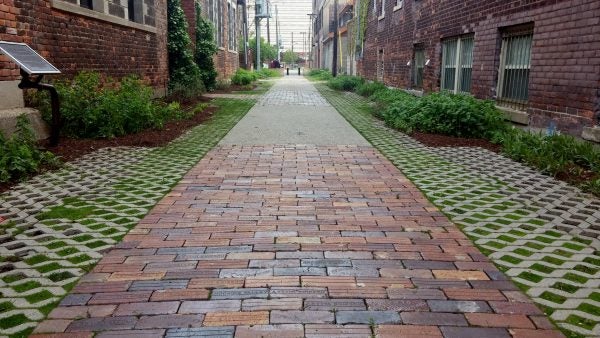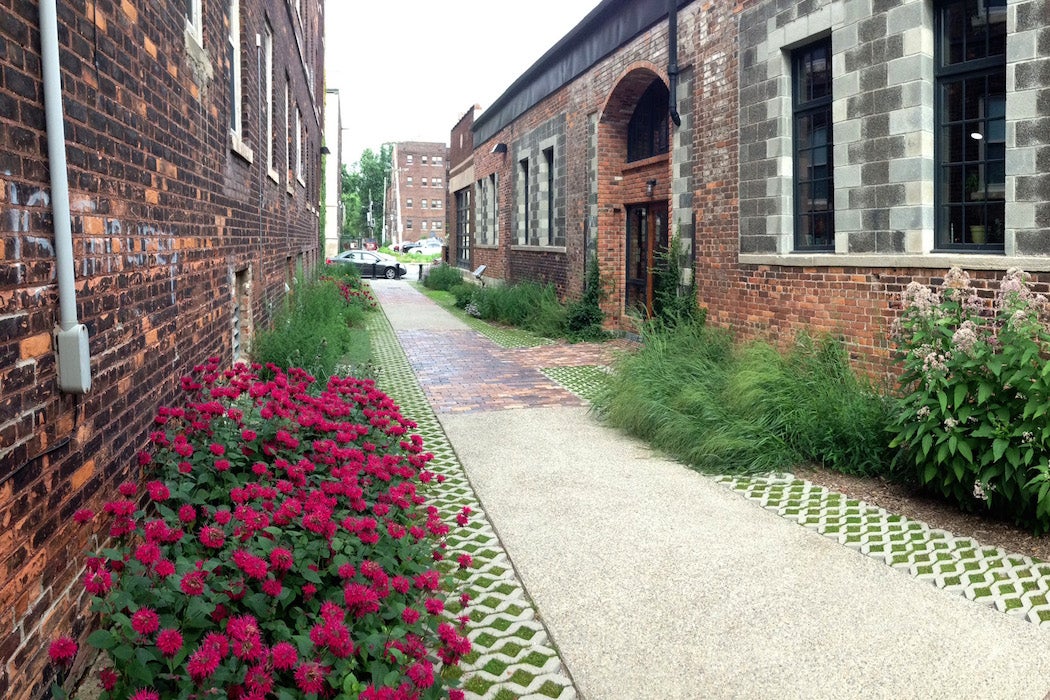When unprecedented “1000-year” floods hit Nashville’s combined sewer system in 2010, the water left was filthy. Rainwater runoff, domestic sewage, and industrial wastewater flowed together into a toxic stew that was far more than the local sewage treatment system could handle.
City leaders and residents of neighborhoods like the Nations and East Nashville were disgusted by the dirty water both standing around and being discharged into rivers like the Cumberland. A local nonprofit, the Cumberland River Compact, stepped up to help install a way to lessen future flooding: designing and planting rain gardens in previously neglected residential alleys.
On a recent steamy morning in June, carpenter bees zoomed around the bright coneflower, echinacea, and bee balm on a small plot of earth in East Nashville’s Eastwood neighborhood. It was part of the compact’s resulting Green Alley Program, which has helped water-seal more than 150 alleys to date by creating space where water can soak into the earth rather than flowing into the combined sewer system.
Program manager Will Caplenor surveyed the mini-garden proudly. No new drains had been installed, just 50 square feet of spongy, absorbent earth and heat-tolerant plantings. With help from a landscape architect, the compact had designed five rain garden templates to accommodate different amounts of sunlight and shade received in each space. Today was dry, but should rains come, well-tended berms in this garden and others would help direct the water away from storm sewers and down into the earth.
Taunia Rice, an Eastwood resident since 1989, alternated between detailing her car and weeding this rain garden, which sat in the alley out back of her house. The 2010 floods had been “crazy,” she said, but the plantings had helped keep water in check since. Previously, Nashville alleys like this one had often built up trash, brush, and other debris that often washed away and contributed to sewer blockage. “When we heard about it, we were like, ‘What is a rain garden?’” Rice remembered. “We thought it seemed like a fantastic opportunity.”

Around the corner, Caplenor pointed out how another 80-square-foot garden that had a drainage pipe running right to it was purposefully sunken. Site-specific accommodations were part of the plan, and while some gardens were carefully weeded and others more overgrown with plants, they all created stormwater-absorption benefits. Multimillion-dollar grants funded the plants, and volunteers did the planting. “Almost all of this was spurred by 2010,” Caplenor said. “That kind of opened Nashvillians’ eyes on exactly what’s going on. Urban sprawl and flooding are what people are really worried about here.”
Roots of a Rethinking
A handful of farsighted researchers saw this coming. In the late 1970s, a Louisville academic named Grady Clay argued that American cities would densify in the future, and should better use their alley space as they did.
“As energy costs go up, as moving and commuting costs increase, the value of older city blocks is likely to stabilize or even to soar in select locations,” Clay wrote in his book Alleys: A Hidden Resource. “Thousands of alley blocks can be transformed by simple reforms.” But as suburbs continued to sprawl out, American planners seemed to pay little attention. Entire new subdivisions were laid out without alleys. Meanwhile, the pre-World War I alleys in urban areas—often soft surfaces of gravel and grass—were often paved over, then nearly abandoned.
In the past couple decades, landscape architecture professor Michael David Martin of Iowa State University took up Grady’s call, studying the towns and neighborhoods where alleys were successful at doing everything from growing gardens and draining stormwater to creating neighborhood cohesion. Architecture students and the New Urbanism movement slowly took notice of what these humble little back routes could do—especially when they hosted more plants and less pavement.
Now, as American cities grow denser and climate-change effects—including Nashville’s major rainstorms—intensify, key cities are indeed starting to rethink their alleyways, especially to mitigate flooding and create heat-reducing green space. “In certain places people are starting to appreciate alleys as green infrastructure,” Martin says. “You’re starting to see gravel, plantings, wildlife habitat in places of high densities. They’re a valuable thing to preserve.”
Permeable Pavement
In the past few years, U.S. cities have quickly followed each other’s lead improving their alleys into more widely usable and eco-friendly spaces. Chicago—never shy about building massive infrastructure—was an early leader. It piloted a citywide project in 2006 to repave hundreds of its flood-prone alleys (which amount to 1,900 miles of pavement in total) with more porous material.
The “Green Alley Project” repaving isn’t uniform. Some Chicago alleys now use permeable asphalt, others permeable concrete, and others pavers with space between for water to seep. Such asphalts and concretes start with larger stones rather than fine-ground sand, and add cellulose fibers to hold the pavement together. This increases the air void by up to 20 percent, allowing more rainwater to seep through.
In addition to their increased perviousness, Chicago’s permeable pavement is even greener because it uses recycled materials like concrete aggregate, slag (a steelmaking byproduct), and old tire rubber incorporated as sub-base or into the concrete or asphalt mix. Water seeps slowly through the sub-base and into the earth.
Weekly Newsletter
Pitching and grading of the pavement is key. In some spots, catch basins connected with perforated pipe are installed in retention trenches to capture and funnel water. Unlike in Nashville, where high points are in the alley’s middle so that water flows to the absorbent rain gardens planted along the edges, Chicago’s alleys are generally graded to bring runoff to the center of the alley.
From there the water flows into the street and the existing sewer system. (Although it also has a combined sewer system, Chicago has upgraded its stormwater-handling system significantly over the past few decades. The city’s Metropolitan Water Reclamation District expanded to handle nearly 14 billion gallons across its Tunnel and Reservoir Plan, which holds stormwater in reservoirs until the district can treat it. The reservoir system is estimated to have eliminated more than half of all possible sewer overflows since 1980, and it will expand to an 18-billion-gallon capacity within the next decade.)
In another wise climate-change-prep move that goes beyond flood control, the lighter-colored surface of high-albedo pavement is used to reflect rather than absorb sunlight in Chicago’s green alleys. This helps reduce the urban heat-island effect.
By the end of last year, more than 300 of Chicago’s back routes had been repaved into green alleys. The city had also published the “Chicago Green Alley Handbook” action guide outlining precisely how residents could take 11 additional measures to make their alleys more sustainable, from composting and tree-planting to adding green roofs and bioswales—landscape elements used to slow, collect, and filter stormwater. These features turn cities into “sponges,” another term for flood-resistant metropolises.

Building on Success
A Detroit team used Chicago’s project handbook as a guide in 2008, when its members piloted the Detroit Green Alley. Business owners along the Midtown alley repaved the stretch with a filtering substrate of rocks and soil, topped by concrete lattice pavers and reclaimed bricks. They added LED lighting, and along the alley’s edges planted a native garden of wild-looking plants like milkweed, goldenrod, and coneflower. The Midtown alleys, like Nashville’s green alleys, are convex-shaped, so water flows out to the absorbent planting systems at the edges.
The Detroit Green Alley reopened in 2010. Four years later, the second-heaviest single-day rainfall Detroit ever recorded caused such massive flooding that people abandoned their cars on the highway. Proving its worth, the green alley didn’t retain a single puddle.
Now Midtown has more than more than half a dozen eco-friendlier alleys, with so many more planned that it’s considering seeking an “alley district” designation. What’s more, as Detroit’s water and sewer department introduced drainage fees and mitigation tax credits in the past few years, the Detroit Green Alley was held up as a model of what kind of efforts would earn mitigation credits.
San Francisco’s planning department published a how-to Living Alleys Toolkit, which depicted the Midtown Detroit project as a guide. L.A., Seattle, and of course Nashville are among the other cities that have since piloted their own projects. As cities grow denser and climate change intensifies, bringing more heat waves, flooding, and other problems, don’t be surprised to spot more.
“We saw it as an opportunity in space that was underutilized,” says Caplenor, of the Cumberland River Compact. “Since I’ve been working on the project I’ve definitely taken more notice of alleys. I see a ton of potential there.”







